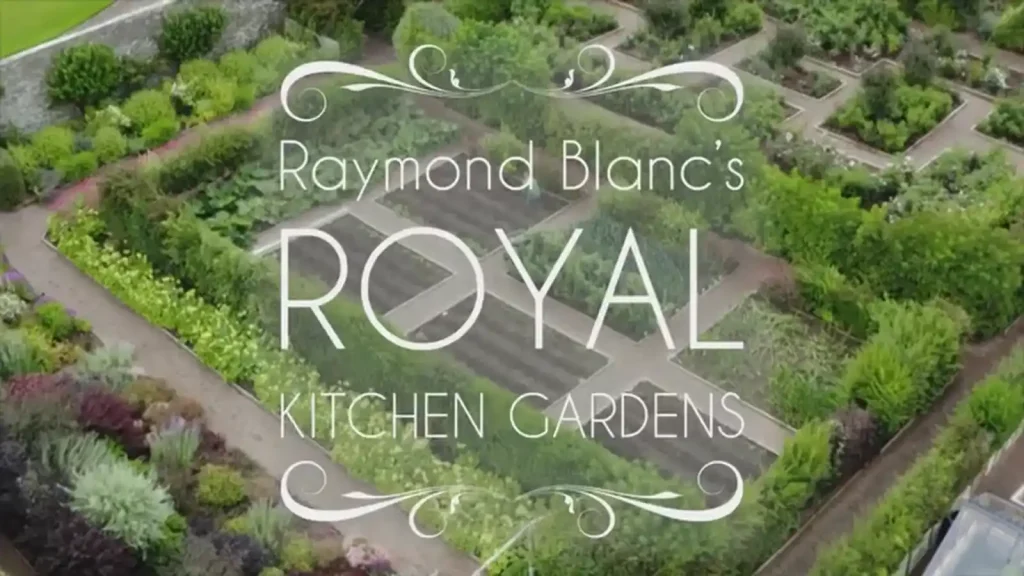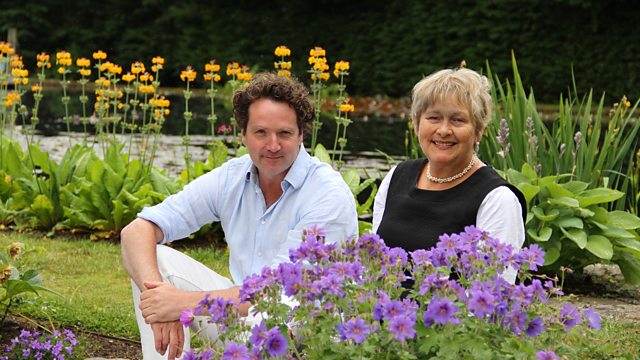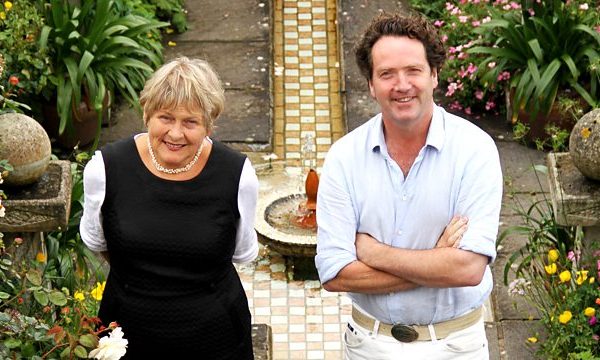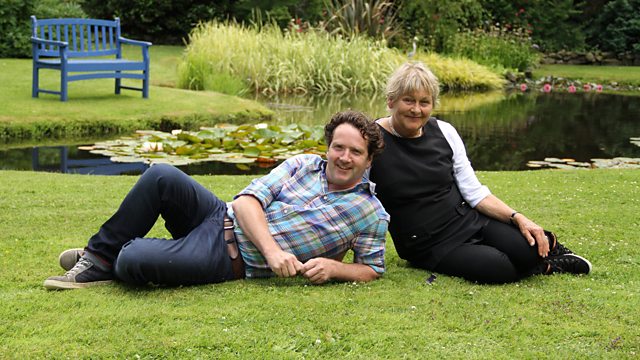Raymond Blanc’s Royal Kitchen Gardens episode 1: In the inaugural episode of “Raymond Blanc’s Royal Kitchen Gardens,” celebrated chef Raymond Blanc embarks on a culinary adventure beginning at the majestic Hampton Court Palace. Known for its stunning architecture and historical significance, Hampton Court is also home to some of the most exquisite walled gardens in the UK. Blanc is joined by historian Tracy Borman, who delves into the rich history of the palace’s gardens, shedding light on their evolution and the royal traditions that have shaped them.
Chef Raymond Blanc, a multi-award-winning author and culinary maestro, invites viewers on an extraordinary journey through the United Kingdom’s Royal kitchen gardens. This brand-new ten-part series, brimming with charm and culinary insights, showcases the beauty and bounty of these historic spaces. Blanc travels across the country, visiting Royal kitchen gardens, engaging with the dedicated gardeners who maintain them, and collaborating with the chefs who bring their produce to life in the kitchen.
The series not only highlights the aesthetic beauty of these gardens but also emphasizes their role in sustainable living and culinary innovation. His Majesty King Charles III, a staunch advocate of the kitchen garden movement, has infused his passion for gardening, sustainability, and outdoor culinary spaces into the Royal households. The King’s personal interests have transformed these gardens into breathtaking sanctuaries of organic produce and environmental stewardship.
“Raymond Blanc’s Royal Kitchen Gardens” promises an enlightening and mouth-watering tour, from the famed apple tunnel at Highgrove to the windswept, sea-scented gardens of the Castle of Mey. Throughout the series, Blanc will explore five of the nation’s most impressive kitchen gardens, offering viewers an exclusive peek into these horticultural havens.
Each episode is a blend of history, horticulture, and haute cuisine. Blanc’s visit to Hampton Court Palace sets the tone for the series. Nestled along the banks of the River Thames, Hampton Court’s gardens are a testament to centuries of royal gardening prowess. Tracy Borman provides a historical backdrop, explaining how these gardens have been meticulously maintained and adapted over the years to serve both aesthetic and practical purposes.
As Blanc tours the gardens, he engages with the head gardener, who shares insights into the seasonal planting and harvesting routines that keep the garden thriving. The walled gardens of Hampton Court are a treasure trove of heirloom vegetables, aromatic herbs, and fruit trees, each with its own unique story and culinary potential. Blanc’s excitement is palpable as he samples fresh produce straight from the garden, envisioning the dishes he can create with these pristine ingredients.
Blanc’s journey is not just about exploration; it’s also about inspiration. He demonstrates how to incorporate garden-fresh ingredients into everyday cooking, making gourmet meals accessible to home cooks. His recipes, inspired by the produce he encounters, are simple yet sophisticated, emphasizing flavor and freshness. Viewers will learn to appreciate the joy of cooking with ingredients that are not only locally sourced but also imbued with history and tradition.
Raymond Blanc’s Royal Kitchen Gardens episode 1
The series also delves into the practical aspects of maintaining a kitchen garden. Viewers gain valuable tips on organic gardening practices, composting, and pest control, all of which contribute to a healthy and sustainable garden. Blanc’s conversations with the gardeners reveal the dedication and passion required to keep these historical gardens flourishing.
In subsequent episodes, Blanc’s culinary journey takes him to other notable Royal residences, each with its own unique garden. At Highgrove, the private residence of King Charles III, viewers will be enchanted by the famed apple tunnel and the extensive vegetable gardens. Blanc meets with the estate’s gardeners to discuss the principles of organic farming and biodiversity that are central to Highgrove’s ethos.
The series also visits the Castle of Mey in Scotland, where the rugged coastal climate creates a distinct growing environment. Here, Blanc explores the challenges and rewards of gardening by the sea, tasting produce that has been shaped by the briny air and resilient soil. The Castle of Mey’s gardens offer a stunning contrast to the more sheltered and temperate gardens of southern England, showcasing the diversity of the UK’s horticultural landscape.
Throughout “Raymond Blanc’s Royal Kitchen Gardens,” the common thread is a deep respect for nature and a commitment to sustainability. Blanc’s passion for fresh, locally grown ingredients aligns perfectly with the ethos of the Royal gardens. His interactions with the gardeners and chefs are a testament to the collaborative spirit that underpins this series. Together, they celebrate the bounty of the land and the culinary traditions that it inspires.
The series culminates in a celebration of the Royal kitchen gardens as living museums of horticultural excellence and culinary tradition. Each garden is a testament to the skill and dedication of the gardeners who tend them and the chefs who transform their produce into culinary masterpieces. Blanc’s journey is an invitation to viewers to explore, appreciate, and emulate the Royal kitchen garden philosophy in their own lives.
“Raymond Blanc’s Royal Kitchen Gardens” is more than just a cooking show; it’s a tribute to the art of gardening and the joy of cooking with fresh, sustainable ingredients. It’s a journey through time and taste, guided by one of the world’s most beloved chefs. Join Raymond Blanc as he uncovers the secrets of the Royal kitchen gardens and brings their stories to your table.
The Royal Kitchen Gardens: A Culinary Journey Through History
Introducing Raymond Blanc’s Royal Adventure
Picture a lush, verdant garden, teeming with life and bursting with flavors. This is the world that renowned chef Raymond Blanc has stepped into, a realm where culinary artistry meets horticultural mastery. As we embark on this gastronomic odyssey, we find ourselves transported to the heart of British royal history, where the humble kitchen garden takes center stage.
Raymond Blanc, a name synonymous with culinary excellence, has long harbored a deep-seated passion for gardens. His own garden at Le Manoir-Cats-Sézent stands as a testament to this love affair with nature’s bounty. But now, he’s venturing beyond his familiar grounds, drawn by the allure of royal kitchen gardens that have fed monarchs for centuries.
The Allure of Hampton Court Palace
As our journey begins, we find ourselves standing before the majestic gates of Hampton Court Palace. This architectural marvel, steeped in Tudor history, holds within its walls secrets of royal feasts and centuries-old culinary traditions. The palace’s kitchen gardens, once the domain of kings and queens, now beckon to us, promising a treasure trove of edible delights.
Hampton Court Palace isn’t just any historical site; it’s a living, breathing testament to the evolution of British cuisine. As we step onto its grounds, we can almost hear the echoes of past royal banquets and smell the aromatic herbs that have graced countless royal dishes. The palace’s 60-acre garden, now open to the public, stands as a bridge between past and present, inviting us to explore the rich tapestry of British culinary heritage.
But what makes this adventure truly extraordinary is the royal connection that threads through it. King Charles III, a passionate advocate for sustainable and seasonal food, has long championed the importance of kitchen gardens. His commitment to organic farming and food provenance aligns perfectly with Raymond’s own culinary philosophy, creating a fascinating intersection of royal tradition and modern gastronomy.
As we prepare to delve deeper into the wonders of Hampton Court’s kitchen gardens, we’re not just observers; we’re participants in a culinary revolution that’s been centuries in the making. From the humble broad bean to the majestic Scottish Giant Leek, every plant in these gardens has a story to tell. And who better to guide us through this edible wonderland than Raymond Blanc himself?
So, are you ready to unearth the secrets of royal kitchen gardens? To discover how centuries-old traditions are shaping modern cuisine? To taste history itself? Then join us as we embark on this extraordinary journey through time, taste, and royal tradition. The gardens await, and with them, a world of culinary possibilities that will tantalize your senses and ignite your passion for food.
Unveiling the Secrets of Hampton Court’s Kitchen Gardens
A Glimpse into Tudor Culinary History
Step into the Great Hall of Hampton Court Palace, and you’re instantly transported to a world of opulence and excess. This cavernous space, once the epicenter of Tudor feasts, whispers tales of lavish banquets and royal indulgence. As you stand amidst the towering walls and ornate tapestries, it’s easy to imagine the bustling scenes that unfolded here centuries ago.
In Tudor times, the Great Hall wasn’t just a dining room; it was the beating heart of the palace. Here, hundreds of courtiers would gather, their appetites as voracious as their ambitions. But what exactly did these Tudor elites consume? Brace yourself for a shock: the average Tudor at court devoured a staggering 4,000 to 5,000 calories daily! This wasn’t mere gluttony; it was a display of wealth and power, as tangible as the thick stone walls surrounding them.
The Modern Kitchen Garden: A Horticultural Marvel
Fast forward to the present day, and Hampton Court’s kitchen gardens continue to captivate and inspire. Meet Hilary, the aptly titled Keeper of the Kitchen Garden. With a twinkle in her eye and soil under her nails, Hilary is the modern-day guardian of this horticultural treasure trove.
As you wander through the neatly arranged beds, you’ll discover a dizzying array of produce that would make any chef’s heart skip a beat. From familiar favorites to rare heirloom varieties, the garden is a living catalog of biodiversity. But it’s not just about quantity; it’s about quality and connection to the past. Each plant, lovingly tended, carries within it the DNA of centuries of careful cultivation.
From Garden to Plate: Chef Neil Roster’s Culinary Artistry
Now, let’s turn our attention to the man who transforms these garden gems into culinary masterpieces: Chef Neil Roster. With the enthusiasm of a child in a candy store, Neil starts each day with a visit to the garden, hand-selecting the ingredients that will star in his creations.
Watch as Neil lovingly cradles a perfectly ripe tomato or inhales the fragrant aroma of just-picked herbs. For him, these aren’t just ingredients; they’re the building blocks of gastronomic art. His approach to cooking is a delicate dance between respecting tradition and embracing innovation.
Take, for instance, his signature Chalkstream Trout dish. The star of the show is, of course, the trout, sourced from Hampshire’s pristine chalk streams. But it’s the supporting cast of garden-fresh vegetables that elevates this dish from mere sustenance to a sensory experience. As Neil plates the dish, each element falls into place like brushstrokes on a canvas, creating a visual and gustatory masterpiece.
The result? A plate that not only tantalizes the taste buds but also tells a story – a story of the land, of centuries of cultivation, and of the enduring connection between garden and table. It’s a testament to the magic that happens when history, horticulture, and culinary expertise collide.
So, the next time you savor a perfectly prepared meal, take a moment to consider its journey. From seed to plate, from Tudor banquet halls to modern kitchens, the legacy of Hampton Court’s kitchen gardens lives on in every bite. And who knows? You might just be inspired to start your own culinary adventure, right in your backyard.
Raymond Blanc’s Culinary Tributes to Hampton Court
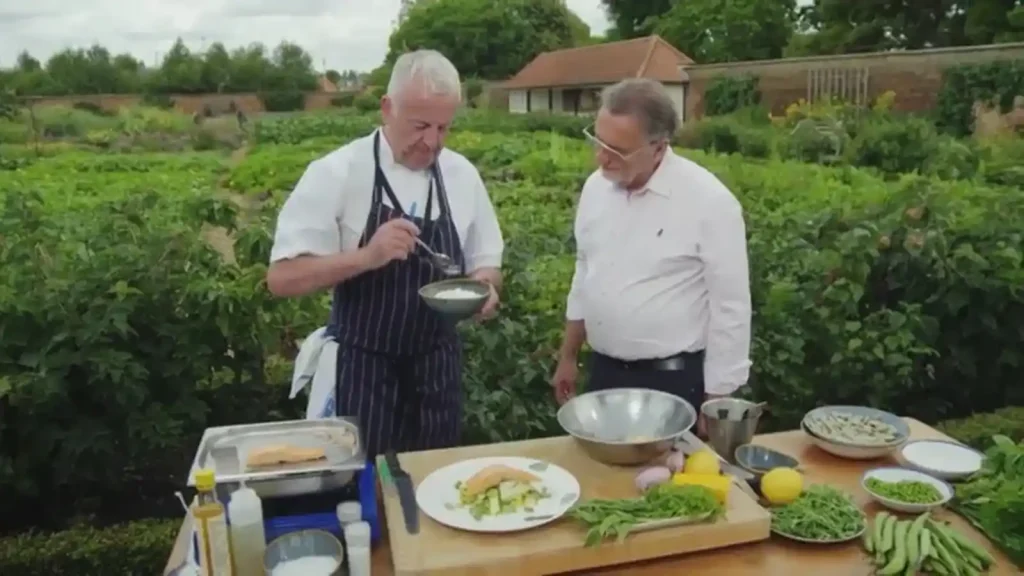
Iced Cassise Parfait: A Frozen Homage to Hampton Court’s Berries
As the sun dips below the horizon, casting a golden glow over Hampton Court’s lush gardens, Raymond Blanc stands in the kitchen, his eyes twinkling with excitement. In his hands, he cradles a bowl of plump, juicy blackcurrants, their deep purple hue a testament to their ripeness. These aren’t just any berries; they’re the crown jewels of Hampton Court’s kitchen garden, and Raymond is about to transform them into a dessert fit for royalty.
With the precision of a master craftsman, Raymond begins the alchemical process of creating his Iced Cassise Parfait. Each step is a dance of flavors and textures, a delicate balance of sweet and tart, smooth and crunchy. As he gently cooks the blackcurrants, the kitchen fills with an intoxicating aroma, transporting us to sun-drenched berry patches and lazy summer afternoons.
Herb-Stuffed Leg of Lamb with Salsa Verde: A Royal Feast
Moving from sweet to savory, Raymond’s eyes light up as he unveils a magnificent leg of lamb. This isn’t just any roast; it’s a canvas on which he’ll paint a masterpiece of flavors, inspired by the bountiful herbs of Hampton Court’s gardens. With deft hands, he begins to create a stuffing that’s nothing short of revolutionary.
Mint, parsley, and marjoram dance together in a herbaceous waltz, their flavors amplified by the addition of anchovy and garlic. As Raymond massages this aromatic mixture into the lamb, it’s as if he’s whispering secrets to the meat, coaxing out its most sublime flavors. The salsa verde that accompanies this dish is a bold departure from traditional mint sauce, a nod to the ever-evolving nature of British cuisine.
The Art of Seasonal Cooking: Lessons from Hampton Court
As the aromas of roasting lamb and simmering berries mingle in the air, Raymond pauses to reflect on the profound lessons Hampton Court’s kitchen gardens have imparted. In this moment, surrounded by the fruits of centuries of horticultural wisdom, he’s not just a chef; he’s a student of history, a guardian of tradition, and an innovator pushing the boundaries of modern cuisine.
The concept of seasonal cooking isn’t just a trendy catchphrase for Raymond; it’s a philosophy deeply rooted in the rhythms of nature. As he gestures towards the window, where the kitchen garden sprawls in all its glory, he speaks passionately about the importance of using ingredients at their peak. “It’s not just about taste,” he muses, “it’s about respecting the earth and the cycles of life.”
Indeed, Raymond’s culinary creations are more than mere dishes; they’re edible time capsules, capturing the essence of Hampton Court’s rich history and vibrant present. Through his expert hands, the humble produce of the kitchen garden is elevated to gastronomic heights, proving that true luxury lies not in rare or exotic ingredients, but in the perfect harmony of flavors that nature provides.
As the final dishes are plated, each one a symphony of colors, textures, and aromas, it’s clear that Raymond has achieved something truly special. He’s not just cooked a meal; he’s woven a tapestry of flavors that tells the story of Hampton Court, from its Tudor beginnings to its place in modern British cuisine. And as we prepare to savor these culinary masterpieces, we’re not just eating; we’re participating in a centuries-old tradition, one delicious bite at a time.
FAQs: Raymond Blanc’s Royal Kitchen Gardens episode 1
What is the historical significance of Hampton Court’s kitchen gardens?
Hampton Court’s kitchen gardens are not just patches of soil; they’re living time capsules that whisper secrets of culinary history. These gardens have been feeding royalty and courtiers for centuries, playing a crucial role in shaping British cuisine as we know it today.
Originally established in the Tudor era, these gardens were the lifeblood of the palace’s kitchens. They provided a diverse array of fruits, vegetables, and herbs that graced the tables of kings and queens. As you walk through these historic plots, you’re treading the same paths as royal gardeners who once carefully tended these grounds to satisfy the appetites of monarchs like Henry VIII and Elizabeth I. The gardens have evolved over time, reflecting changing tastes and horticultural practices, but their core purpose remains unchanged: to provide fresh, seasonal produce of the highest quality.
How does King Charles III’s passion for sustainable food align with Hampton Court’s practices?
King Charles III’s advocacy for sustainable food production isn’t just a modern fad; it’s a continuation of a centuries-old tradition exemplified by Hampton Court’s kitchen gardens. His Majesty’s commitment to organic farming and local food systems resonates deeply with the ethos that has long guided these royal gardens.
At Hampton Court, sustainability isn’t just a buzzword—it’s a way of life. The gardeners here employ time-honored techniques that minimize environmental impact while maximizing yield and flavor. From companion planting to natural pest control methods, every practice in these gardens echoes King Charles’s vision for a more sustainable food future. Moreover, the emphasis on seasonal eating and reducing food miles aligns perfectly with the palace’s historical approach to cuisine, where the menu was dictated by what was ripe and ready in the gardens just outside the kitchen door.
What unique varieties of vegetables can be found in Hampton Court’s kitchen gardens?
Prepare to have your mind—and taste buds—blown by the cornucopia of unique vegetable varieties thriving in Hampton Court’s kitchen gardens. These plots are a veritable Noah’s Ark of plant biodiversity, preserving heirloom varieties alongside modern cultivars.
One of the stars of the show is the Scottish Giant Leek, a behemoth that looks more like a small tree than a vegetable. Its massive size is matched only by its intense, sweet flavor. Then there’s the Bulgarian Giant, a bean variety that produces pods so large they might make Jack (of beanstalk fame) do a double-take. But it’s not all about size—you’ll also find delicate herbs like Thai basil and chervil, adding exotic notes to the garden’s symphony of scents and flavors. These unique varieties aren’t just curiosities; they’re living links to our culinary past and potential building blocks for our gastronomic future.
How does Chef Neil Roster incorporate garden-fresh ingredients into his dishes?
Chef Neil Roster’s approach to cooking is like watching a painter select colors for a masterpiece. Each morning, he steps into the kitchen gardens, basket in hand, ready to let nature dictate the day’s menu. This isn’t just farm-to-table; it’s more like plant-to-plate.
Neil’s dishes are a celebration of Hampton Court’s horticultural bounty. Take his Chalkstream Trout dish, for instance. The star of the show might be the succulent fish, but it’s the supporting cast of garden-fresh vegetables that elevates the dish to royal heights. Tender pea shoots, crisp courgette ribbons, and fragrant herbs picked mere moments before plating create a sensory experience that’s as much a feast for the eyes as it is for the palate. By letting the garden guide his culinary creations, Neil ensures that each dish tells a story—a story of the land, the season, and the centuries of tradition that have shaped Hampton Court’s cuisine.
What are some key techniques Raymond Blanc uses in his recipes inspired by Hampton Court?
Raymond Blanc’s culinary techniques are like a beautiful dance between tradition and innovation, with Hampton Court’s kitchen gardens providing the rhythm. His approach is all about honoring the inherent qualities of each ingredient while elevating them to new heights of gastronomic delight.
One key technique Raymond employs is the art of infusion. Take his Iced Cassise Parfait, for example. He doesn’t just use blackcurrants; he coaxes out their essence, allowing their vibrant flavor to permeate every molecule of the dessert. Another signature move is his approach to herbs. In his Herb-Stuffed Leg of Lamb, Raymond doesn’t just sprinkle herbs as an afterthought. Instead, he creates a complex stuffing where each herb plays a crucial role, forming a symphony of flavors that complements the rich meat perfectly. But perhaps his most important technique isn’t about cooking at all—it’s about listening. Raymond listens to the gardens, allowing the seasonality and unique qualities of Hampton Court’s produce to guide his culinary creations, resulting in dishes that are both timeless and thoroughly modern.
Conclusion: Raymond Blanc’s Royal Kitchen Gardens episode 1
The Intersection of History, Sustainability, and Culinary Excellence
As we draw the curtains on our journey through Hampton Court’s royal kitchen gardens, we’re left with a profound sense of awe. These hallowed grounds, where history, sustainability, and culinary artistry converge, are far more than mere plots of land. They are living, breathing testaments to centuries of horticultural wisdom and gastronomic innovation.
The legacy of these gardens extends far beyond the palace walls. They serve as a bridge between past and present, showcasing how traditional practices can inform and enhance modern sustainability efforts. From the careful selection of heirloom varieties to the implementation of organic growing techniques, Hampton Court’s gardens embody a holistic approach to food production that resonates deeply in our contemporary world. Moreover, they remind us that the pursuit of culinary excellence is inextricably linked to our stewardship of the earth.
Inspiring Home Cooks and Gardeners
But what does this mean for you, the home cook or aspiring gardener? Well, the royal kitchen gardens aren’t just for admiring from afar. They’re a wellspring of inspiration, brimming with ideas that you can adapt to your own culinary adventures. Perhaps you’ll be inspired to start an herb garden on your windowsill, or experiment with heirloom vegetable varieties in your backyard plot.
The lessons from Hampton Court are clear: cook with the seasons, celebrate local produce, and approach each ingredient with reverence. You don’t need a palace-sized garden to embrace these principles. Even a small pot of homegrown basil can transform your cooking, connecting you to the rich tapestry of culinary history that stretches back through the centuries. By doing so, you’re not just preparing a meal; you’re participating in a timeless tradition that links you to generations of cooks and gardeners who came before.
As we close this chapter, let’s take a moment to reflect on the incredible journey we’ve taken. From the opulent Tudor feasts to the sustainable practices championed by King Charles III, from Raymond Blanc’s innovative creations to the everyday magic of fresh, seasonal produce, we’ve seen how royal kitchen gardens continue to shape our understanding of food and its place in our lives. These gardens are more than historical curiosities; they’re living laboratories of taste, sustainability, and cultural heritage.
So the next time you step into your kitchen or tend to your garden, remember the legacy of Hampton Court. Let it inspire you to approach your culinary endeavors with a sense of wonder, respect for tradition, and an eye towards sustainability. After all, every meal you prepare, every seed you plant, is an opportunity to connect with this rich heritage and to write your own chapter in the ongoing story of our relationship with food. The royal kitchen gardens may be rooted in history, but their lessons are timeless, offering a blueprint for a more delicious, sustainable, and connected future.
